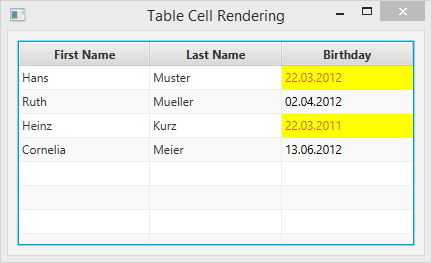In this post I will show how to customize the rendering of a JavaFX TableView. This is an updated version of the JavaFX 2 TableView Cell Renderer article. Compared to the old version, we can now use some Java 8 language features like lambda expressions and the new Date and Time API.
Following is how the result will look like.

- The Birthday column is a formatted
LocalDateobject. - All birthdays in March receive a yellow background and a brown text color.
How a Table Cell is Rendered
Each table cell will receive an object, in our case it is an instance of Person. To do the rendering, the cell will need a Cell Value Factory and a Cell Factory:
Cell Value Factory
The cell must know which part of Person it needs to display. For all cells in the birthday column this will be the Persons birthday value.
This is our birthday column:
private TableColumn<Person, LocalDate> birthdayColumn;
And later during initialization, we’ll set the Cell Value Factory:
birthdayColumn.setCellValueFactory(
cellData -> cellData.getValue().birthdayProperty());
So far nothing too fancy.
Cell Factory
Once the cell has the value, it must know how to display that value. In our case, the birthday’s LocalDate value must be formatted and colored depending on the month.
DateTimeFormatter myDateFormatter = DateTimeFormatter.ofPattern("dd.MM.yyyy");
// Custom rendering of the table cell.
birthdayColumn.setCellFactory(column -> {
return new TableCell<Person, LocalDate>() {
@Override
protected void updateItem(LocalDate item, boolean empty) {
super.updateItem(item, empty);
if (item == null || empty) {
setText(null);
setStyle("");
} else {
// Format date.
setText(myDateFormatter.format(item));
// Style all dates in March with a different color.
if (item.getMonth() == Month.MARCH) {
setTextFill(Color.CHOCOLATE);
setStyle("-fx-background-color: yellow");
} else {
setTextFill(Color.BLACK);
setStyle("");
}
}
}
};
});
The Cell Factory contains some complicated stuff (Lambda expression, Generics and Anonymous Inner Classes). Don’t worry too much about all this. Just focus on the important part which is the updateItem(...) method.
The updateItem(...) method gets called whenever the cell should be rendered. We receive the LocalDate item that must be rendered. If the item is empty we reset the cell. Otherwise, we format the item and set the text of the cell. Depending on the month, we also set some color.
Rendering ListView and TreeView Cells
Note that the JavaFX ListView and TreeView are rendered in a very similar way.
Download
Download the complete source of the TableView Cell Renderer Example.